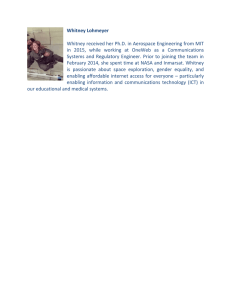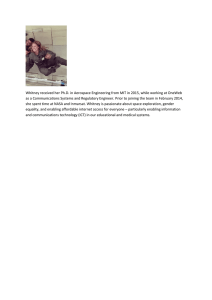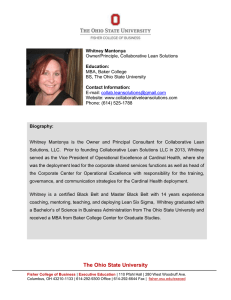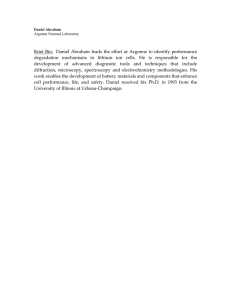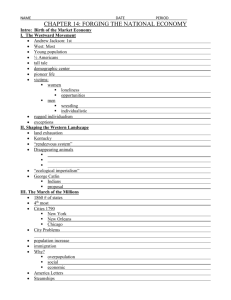Constraints and Metrics in Technical Networks 8/24/2006 © Daniel E Whitney 1997-2006
advertisement
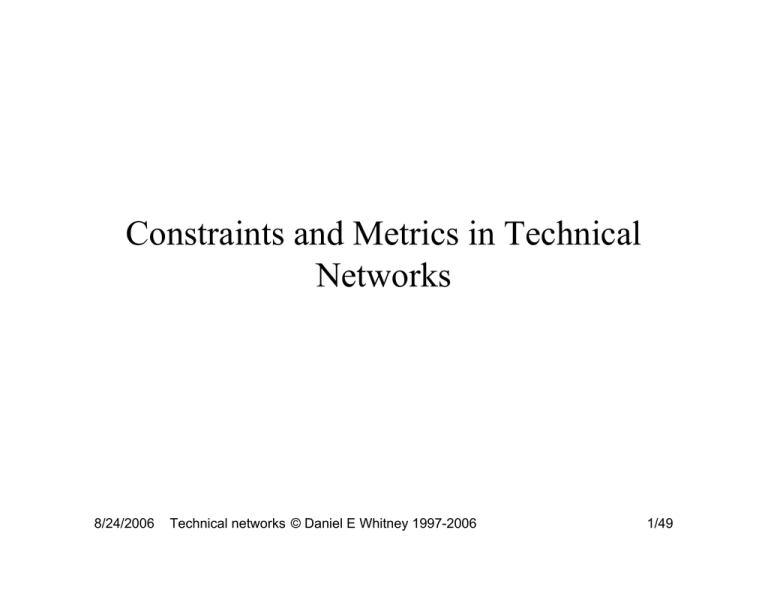
Constraints and Metrics in Technical Networks 8/24/2006 Technical networks © Daniel E Whitney 1997-2006 1/49 Goals of This Class • Metrics as indicators of system properties that may be related to structure or behavior • Their relation to the constraints under which the systems evolved or in view of which the systems were designed • Modeling problems 8/24/2006 Technical networks © Daniel E Whitney 1997-2006 2/49 Designed and Grown Systems • Designed implies some degree of top-down control of the architecture • Grown does not mean random • Social systems – Designed: organizations, supply chains – Grown: coauthors, company directors • Technical systems – Designed: assemblies, PSTN, factories, national highway network – Grown: regional or national electric grid, local roads outside of Northwest Territory • Harder to classify (social?, grown?) – A city and its water supply or subway system 8/24/2006 Technical networks © Daniel E Whitney 1997-2006 3/49 Pearson Coefficient for Technical Systems • A widely studied metric that captures some elements of structure and possibly is related to behavior • Distribution systems - grids or stars or trees or trees with cross-links • Mechanical assemblies - trees • Electric and electronic circuits - should be grids – Computer motherboards have a few nodes with huge k – What do they look like inside? – Coarse-graining 8/24/2006 Technical networks © Daniel E Whitney 1997-2006 4/49 Pearson Coefficient for Canonical Systems • • • • Trees, cross-linked trees, and stars have r < 0 Balanced binary trees have r = -1/3 Trees with diminishing branching ratio have r > 0 Trees with big branching ratios explode and r approaches -1 • Finite grids have r approaching 2/3 • Clusters with pendants at each cluster node have r<0 8/24/2006 Technical networks © Daniel E Whitney 1997-2006 5/49 Closed Form Results 1 2 1 2 3 3 4 4 5 5 Property ksum ksqsum x Pure Binary Tree 2 n +1 − 4 10 * 2 n−1 −14 → 2.5 as n becomes large (>~ 6) Pearson numerator Pearson denominator r ~ 2 n (3 − x )(1− x ) + (ksum − 2 n )(3 − x ) 2 ~ 2 n−1(1− x ) 2 + (ksum − 2 n−1 )(3 − x ) 2 1 → − as n becomes large 3 l Bounded grid 8/24/2006 Binary Tree with Cross-linking 3* 2 n −10 13* 2 n − 64 13 → as n becomes large (>~ 6) 3 ~ 2 n (5 − x )(1− x ) + (ksum − 2 n )(5 − x ) 2 ~ 2 n−1(1− x ) 2 + (ksum − 2 n−1)(5 − x ) 2 1 → − as n becomes large 5 Note: Western Power Grid r = 0.0035 16(2 − x )(3 − x ) + 8(l − 3)(3 − x ) 2 2 r= → 2(2 − x ) 2 + 12(l − 2)(3 − x ) 2 3 Technical networks © Daniel E Whitney 1997-2006 6/49 Nested Self-Similar Networks nested r = - 0.25, c = 0.625 nested2 Probably, r = 0 in the limit as the network grows r = - 0.0925, c = 0.5500 8/24/2006 Technical networks © Daniel E Whitney 1997-2006 7/49 Tree with Diminishing Branching Ratio 1 node with k = 16 16 times 16 nodes with k = 9 8 times 8*16 = 128 nodes with k = 5 4 times 4*8*16 = 512 nodes with k = 3 2 times 2*4*8*16 = 1024 nodes with k = 1 r = 0.38166 8/24/2006 Technical networks © Daniel E Whitney 1997-2006 8/49 Trees with Branching Ratio b Pearson Coeff r for Branching Trees 0 0 20 40 60 80 100 120 -0.1 -0.2 -0.3 -0.4 -0.5 -0.6 b=2 b=3 b=4 r -0.7 -0.8 -0.9 -1 Branching Ratio Using approximate formula; tested in matlab with tree-generator written by Mo-Han Hsieh. Actual values are a bit more negative than given by approximate formula for b > 2. 8/24/2006 Technical networks © Daniel E Whitney 1997-2006 9/49 Alignment of System Type and Canonical Shape • Assemblies seem like trees, or trees decorated with loose clusters at different hierarchical levels • Subway systems are like clusters with interior nodes and exterior pendants • Commuter rail lines can be trees, trees with cross-links, or grids – Grids arise when there is a robust intercity rail system and commuter trains can share these tracks – Also helps to have relatively flat ground – Trains must follow flat ground or cost a lot for tunnels – Flat ground is associated with water courses, as are locations of towns that need train service 8/24/2006 Technical networks © Daniel E Whitney 1997-2006 10/49 Network Models of Technical Systems • Need to carefully define what is a node and what is a link • Examples: – Assemblies: node = part; link = joint between two parts tat constrains at least one degree of freedom – Rail lines: node = rail junction or place where people can change train lines; link = rail – Electric circuit: node = circuit element (R, C, IC); link = wire – Distribution infrastructure: node = branch point, load, or sink; link = conductor ( pipe, wire) – Food web: node = species; link (directed) what eats what (can include cannibalism) 8/24/2006 Technical networks © Daniel E Whitney 1997-2006 11/49 Design of Distribution Systems • • • • Fundamental need is to “fill space” in some sense Scaling issues Cost per unit of capability or capacity Levels of service: speed, choice of destination, equity • Context, legacy – Ability to run commuter trains on inter-city tracks – Ability to exceed service of legacy system 8/24/2006 Technical networks © Daniel E Whitney 1997-2006 12/49 Spatial Distribution Networks -1 • Blood, water, sewer, newspapers are one to many or many to one • Urban rail systems can be like this or can be many to many in the core and many to one in the periphery • The phone system is many to many in the core and one to many in the periphery • One to many = tree • Many to many = grid or hierarchy with levelskipping 8/24/2006 Technical networks © Daniel E Whitney 1997-2006 13/49 Spatial distribution networks (Magee slides) • Gastner and Newman analyzed the case where the distribution system has a “root node” which is the sole source or sink for the commodity being distributed. • Additional design factors considered – Additional node locations (constraint) – Total link length (smaller lowers cost ) – Shortest path length between two nodes (smaller lowers transport time) • Tradeoff in last two factors is the design/architecting problem – Look at ideal solutions for each criterion – Examine how real networks compare on the tradeoffs – Build growth model to derive pattern and look for consistency 8/24/2006 Technical networks © Daniel E Whitney 1997-2006 14/49 Spatial distribution networks -2 • Minimum total edge length including paths to the root node is given by a Minimum Spanning Tree (c) while obtaining shortest paths from each node to the root node is optimized by a star graph (b). Actual system is (a) From Gastner, M. T., and M. E. J. Newman. "Shape and efficiency in spatial distribution networks." J Stat Mech (2006): P01015. (Fig. 1) Courtesy the Institute of Physics. Used with permission. 8/24/2006 Technical networks © Daniel E Whitney 1997-2006 15/49 Spatial distribution networks - 3 • From transportation research, a route factor q is where l iois the shortest actual path length and and dio is the shortest Euclidean distance from node i to the origin o q is equal to 1 for a star graph, which has maximum total edge length n 1 l io ≥1 q= ∑ n i=1 dio • For three real technological system networks, From Gastner, M. T., and M. E. J. Newman. "Shape and efficiency in spatial distribution networks." J Stat Mech (2006): P01015. (Table 1) Courtesy the Institute of Physics. Used with permission. • The systems favor minimum edge length but have route factors considerably superior to MST optimums indicating effective tradeoff in the two criteria. • A simple growth model is used to explain this result 8/24/2006 Technical networks © Daniel E Whitney 1997-2006 16/49 Spatial distribution networks -4 • • The growth model assumes that the systems evolve from the root node by linking in new (but already existing) nodes using a greedy optimization criterion that adds unconnected node, i, to an already connected node, j with the weighting factor given by Simulations using these model assumptions yield showing small tradeoffs in total link length give large improvements in path length From Gastner, M. T., and M. E. J. Newman. "Shape and efficiency in spatial distribution networks." J Stat Mech (2006): P01015. (Fig. 3) Courtesy the Institute of Physics. Used with permission. 8/24/2006 Technical networks © Daniel E Whitney 1997-2006 17/49 Spatial distribution networks 5 • What is missing from these studies of spatial distribution networks from your perspective? What future research do these studies suggest? • Consideration of other network properties • Consideration of constraints like geography • Development of more broadly applicable models – More than one source/sink node – Coordination with other networks (subway and commuter or intercity rail) • Development of other rules/protocols for growth that achieve the key properties well • Consideration of top-down vs. evolved systems 8/24/2006 Technical networks © Daniel E Whitney 1997-2006 18/49 London Underground r = 0.0997 Image removed for copyright reasons. Map of the London subway system. See: http://www.tfl.gov.uk/tfl/pdfdocs/colourmap.pdf 8/24/2006 Technical networks © Daniel E Whitney 1997-2006 19/49 Tokyo JR East Lines and Subways rregional rail = −0.0134 rregional rail plus subways = 0.0425 Image removed for copyright reasons. Map of the Tokyo railroad and subway systems. See: http://www.jreast.co.jp/e/info/map_a4ol.pdf 8/24/2006 Technical networks © Daniel E Whitney 1997-2006 20/49 Tokyo Subways Image removed for copyright reasons. Map of the Tokyo subway system. See: http://www.deutsch-japanischer-kulturverein.de/Images/Karte%20Tokyo%20Subway2.jpg 8/24/2006 Technical networks © Daniel E Whitney 1997-2006 21/49 Moscow Metro Image removed for copyright reasons. Map of the Moscow subway system. See: http://meta.metro.ru/moskva/moscow-metro.gif 8/24/2006 Technical networks © Daniel E Whitney 1997-2006 22/49 Moscow Regional Rail Images removed for copyright reasons. Map of the Moscow Regional Rail. 8/24/2006 Technical networks © Daniel E Whitney 1997-2006 23/49 Moscow Metro and Regional Rail Images removed for copyright reasons. Map of the Moscow Metro and Regional Rail. rsubway + rail = 0.2601 8/24/2006 Technical networks © Daniel E Whitney 1997-2006 rsubway = 0.1846 24/49 Berlin U-bahn and S-bahn Images removed for copyright reasons. Map of the Berlin subway and train. See: http://www.lodging-germany.com/info/Berlin/berlin-7citymapubahn.htm 8/24/2006 Technical networks © Daniel E Whitney 1997-2006 r = 0.0957 25/49 Munich U-bahn and S-bahn Images removed for copyright reasons. Map of the Munich subway and train. See: http://www.munich-info.de/images/mvv.jpg 8/24/2006 r = -0.0317 Technical networks © Daniel E Whitney 1997-2006 26/49 Paris Metro and RER Image removed for copyright reasons. Map of the Paris Metro. See: http://www.kigoobe.com/parishotel/img/carte.gif 8/24/2006 Image removed for copyright reasons. Map of the Paris RER. See: http://www.paris.org/Metro/gifs/rer01.map.jpg Technical networks © Daniel E Whitney 1997-2006 27/49 Car and Train Traffic, Paris Trips by Car 20,717,000 Total Trips Trips by Public Transport 14,099,000 (68%) 6,618,000 (32%) Second Ring * First Ring Central Paris 1,156,000 (42%) 1,583,000 (58%) 1,024,000 (35%) 1,935,000 (65%) 394,000 (31%) 820,000 (69%) 3,668,000 (78%) 1,064,000 (22%) 1,373,000 (75%) 446,000 (25%) 6,484,000 (90%) 770,000 (10%) * lle de France region outside Central Paris and First Ring Daily Trips by Mode in the Paris Region Figure by MIT OCW. After figure by Renault Cars UK. Food Webs • These are directed graphs of what eats what • They are classic hierarchies with typically three levels – Top - have no predators – Middle - are both prey and predators – Bottom - have no prey • Trophic species are those with the same predators and prey, so that they look alike from the point of view of the web • Some food webs are quoted in the network literature with or without trophic species condensation, without noting this difference • Data in following slides are from Jennifer Dunne, Santa Fe Institute 8/24/2006 Technical networks © Daniel E Whitney 1997-2006 29/49 Canonical Forms in Food Webs Monoculture Omnivore Free-for-all r<0 r>0 r<0 Figures by MIT OCW. rdir = ∑ (k − x )(k − x ) ∑ (k − x ) ∑ (k − x out in in 2 out 8/24/2006 out out in Technical networks © Daniel E Whitney 1997-2006 2 ) in 30/49 UK Grassland r = - 0.1724 Parasitic insects Herbivore insects Grasses 8/24/2006 Technical networks © Daniel E Whitney 1997-2006 31/49 Chesapeake Bay Trophic species 8/24/2006 Technical networks © Daniel E Whitney 1997-2006 r = -0.2942 32/49 Broom (Scotch Broom Grass) Parasitic insects Predator insects and 5 birds r = 0.2618 Parasitic insects Seed or rooteating insects Scotch broom grass 8/24/2006 Technical networks © Daniel E Whitney 1997-2006 33/49 Little Rock Lake, WI r = -0.3398 Fish, fry, larvae Water fleas Flies 8/24/2006 Technical networks © Daniel E Whitney 1997-2006 Bacteria and algae 34/49 r for Food Webs: Toy Example Seeking the Reason for ± r 8/24/2006 Technical networks © Daniel E Whitney 1997-2006 35/49 Trophic Species Affect r Trophic species = Trophic species are functional groups that contain organisms that appear to eat and be eaten by the exact same species within a food web. r = - 0.7416 r = - 0.3333 r = - 0.0913 In graph theory this is called structural equivalence 8/24/2006 Technical networks © Daniel E Whitney 1997-2006 36/49 Mechanical Assemblies • All analyzed so far have r < 0. • There is usually one or a few foundation parts that support important operating loads and have many parts attached to them • Other parts group into subassemblies but these do not have high clustering coefficient or big differences in nodal degree • The reason is avoidance of mechanical overconstraint 8/24/2006 Technical networks © Daniel E Whitney 1997-2006 37/49 Average Nodal Index for Mechanical Assemblies ≈ 1.5*2 8/24/2006 Technical networks © Daniel E Whitney 1997-2006 38/49 Average Nodal Index Does Not Grow with Network Size, Unlike Most Networks: Why? 8/24/2006 Technical networks © Daniel E Whitney 1997-2006 39/49 Constraint as a Limit on Connectivity • Each time two parts are joined, each part subtracts some number of degrees of freedom from the other. • An unconnected part has 6 dof • Adding more parts may increase or decrease their mutual dof • The chicken comes home to roost when a loop closes and the dof arithmetic has to be summed around the loop • The result could be negative dof! • This is called over-constraint • The Kutzbach criterion formalizes this for simple assemblies • Screw Theory is the definitive method 8/24/2006 Technical networks © Daniel E Whitney 1997-2006 40/49 Constraint and <k> M = 3(n − g − 1) + ∑ joint freedoms fi M > 0 : under - constrained where n = number of parts g = number of joints M = 0 : properly (exactly) constrained M < 0 : over - constrained fi = degrees of freedom of joint i joint freedoms f ∑ β= α = g /n < k >= 2α i number of joints g For M = 0 : 3 − 3n 3 α= → as n gets large 3− β n(β − 3) For spatial mechanisms, replace "3" with "6" 8/24/2006 β α 0 1 1 1 1 .5 1 .2 2 3 1 .5 planar α spatial Technical networks © Daniel E Whitney 1997-2006 41/49 What Matters in Assembly Networks • It’s chains and loops, not clusters • Well, maybe it’s a combination of chains, loops, and clusters • Next few slides give a first pass at this • Main functions are implemented by loops that appear to pass through major hubs • For a class of assemblies: – Functions appear to apply loads – Hubs appear to be load-accumulators, balancers, distributors, shedders 8/24/2006 Technical networks © Daniel E Whitney 1997-2006 42/49 Example Assembly: Exercise Walker 2 5 1 6 3 4 Figure by MIT OCW. 8/24/2006 Technical networks © Daniel E Whitney 1997-2006 43/49 Network Diagram of Walker 4a 22a 8 2 7 11b 36b 2 4 13 2 5 2 6 40a 1 7 1 7 3 2 a 3 2 b 47a 3 3 a ,b ,c 49a 38 1 2 46b 28b 15a 43a 15b 43b 42 33a,b,c 36a 32a 25 11a 41b 45 3 3 a ,b ,c 32b 17 26 27 7 44b 14b 6b 47b 1 7 44a 14a 2 3 49b 41a 6a 28a 3 5b 45 3 3 a ,b ,c 46a 5a 12 40b 23 124 arcs 75 nodes ratio = 1.653 22b “walker” 4b 8/24/2006 Technical networks © Daniel E Whitney 1997-2006 44/49 Walker Horizontal Functional Loops user’s arm 4a user’s leg 22a 8 27 11b 36b 24 13 25 26 40a 17 32a 32b 47a 5a 17 3 3 a ,b ,c 46a 45 3 3 a ,b ,c 49a 41a 28a 3 user’s body 38 5b 2 2 4 9b 46b 15a 43 a 15 b 43 b 1 3 2 8b 42 33a ,b ,c 3 3 a ,b ,c 3 6a 32a 25 11a 41b 45 32 b 17 26 27 7 4 4b 14b 6b 47b 17 44a 14a 6a 12 40b 23 124 arcs 75 nodes ratio = 1.653 22b user’s leg “walker” 4b 8/24/2006 user’s arm Technical networks © Daniel E Whitney 1997-2006 45/49 Walker Vertical Functional Loops 4a user’s leg 22a 8 27 11b 36b 24 13 25 26 40a 17 32a 32b 47a 5a 17 3 3 a ,b ,c 46a 45 3 3 a ,b ,c 49a 41a 28a 3 user’s body 38 5b 2 2 46b 15a 43 a 15 b 43 b 1 3 4 9b 2 8b 42 33a ,b ,c 3 3 a ,b ,c 3 6a 32a 25 11a 41b 45 32 b 17 40b 26 27 7 12 23 124 arcs 75 nodes ratio = 1.653 22b user’s leg “walker” 4b gravity earth 8/24/2006 4 4b 14b 6b 47b 17 44a 14a 6a Technical networks © Daniel E Whitney 1997-2006 46/49 V-8 Engine Functional Loops 8/24/2006 Technical networks © Daniel E Whitney 1997-2006 47/49 Summary Properties of Several Big Networks (Newman) Figure by MIT OCW. Network Type n m z l α 3.48 4.60 7.57 6.19 4.92 2.3 2.1 1.5/2.0 3.2 2.1/2.4 2.1/2.7 3.0/2.7 C(1) C(2) r 0.20 0.59 0.15 0.45 0.088 0.78 0.88 0.34 0.56 0.60 0.208 0.276 0.120 0.363 0.127 0.17 0.005 0.16 0.13 0.001 0.092 -0.029 0.11 0.29 -0.067 0.13 0.15 0.44 0.157 -0.189 -0.003 -0.033 -0.016 -0.119 -0.154 -0.366 -0.240 -0.156 -0.263 -0.326 -0.226 SOCIAL Film actors Company directors Math coauthorship Physics coauthorship Biology coauthorship Telephone call graph E-mail messages E-mail address books Student relationships Sexual contacts undirected undirected undirected undirected undirected undirected directed directed undirected undirected 449913 7673 253339 52909 1520251 47000000 59912 16881 573 2810 25516482 55392 496489 245300 11803064 80000000 86300 57029 477 113.43 14.44 3.92 9.27 15.53 3.16 1.44 3.38 1.66 INFORMATION WWW nd.edu WWW Altavista Citation network Roget's Thesaurus Word co-occurrence directed 269504 directed 203549046 directed 783339 directed 1022 undirected 460902 1497135 2130000000 6716198 5103 17000000 5.55 10.46 8.57 4.99 70.13 11.27 16.18 TECHNOLOGICAL Internet Power grid Train routes Software packages Software classes Electronic circuits Peer-to-peer network undirected undirected undirected directed directed undirected undirected 10697 4941 587 1439 1377 24097 880 31992 6594 19603 1723 2213 53248 1296 5.98 2.67 66.79 1.20 1.61 4.34 1.47 3.31 18.99 2.16 2.42 1.51 11.05 4.28 2.5 1.6/1.4 3.0 2.1 0.035 0.10 0.070 0.033 0.010 0.012 0.39 0.080 0.69 0.082 0.012 0.030 0.011 BIOLOGICAL Metabolic network Protein interactions Marine food web Freshwater food web Neural network undirected undirected directed directed directed 765 2115 135 92 307 3686 2240 598 997 2359 9.64 2.12 4.43 10.84 7.68 2.56 6.80 2.05 1.90 3.97 2.2 2.4 - 0.090 0.072 0.16 0.20 0.18 0.67 0.071 0.23 0.087 0.28 4.95 5.22 16.01 4.87 Basic statistics for a number of published networks. The properties measured are: type of graph, directed or undirected; total number of vertices n; total number of edges m; mean degree z; mean vertex-vertex distance l; exponent α of degree distribution if the distribution follows a power law (or "-" if not; in/out-degree exponents are given for directed graphs); clustering coefficient C(1); clustering coefficient C(2); and degree correlation coefficient r. Blank entries indicate unavailable data. 8/24/2006 Technical networks © Daniel E Whitney 1997-2006 48/49 Additional Networks Social Biological Assemblies (Technological) Transport (Technological) Software Electric (Technological) Network Karate Club Little Rock Lake Food Web Santa Fe Coauthors V8 engine Exercise walker Bike Six speed automatic transmission “HOT” St. Martin Food Web Tokyo Regional Rail Mozilla19980331 Mozilla all comp Munich Schnellbahn Western Power Grid Physics coauthors Tokyo Regional Rail plus Subways London Underground Moscow Subways Company directors Moscow Subways and Regional Rail Scottish Broom Grass Food Web 8/24/2006 n 34 200 m 78 1159 <k> 4.5882 11.59 r -0.4756 -0.3398 118 243 82 131 143 198 367 116 208 244 3.3559 3.01 2.8293 3.1756 3.4126 -0.2916 -0.269 -0.256 -0.2018 -0.1833 1000 44 1049 132 2.098 6 -0.1707 -0.1097 147 204 2.775 -0.0911 811 1187 50 4077 4129 65 5.0271 3.4785 2.6 -0.0499 -0.0393 -0.0317 4941 6594 2.6691 0.0035 145 191 346 300 4.7724 3.1414 0.0159 0.0425 92 139 3.02 0.0997 51 6731 82 50775 3.216 15.09 0.1846 0.2386 129 204 3 0.2601 154 185 2.406 0.2618 Technical networks © Daniel E Whitney 1997-2006 Definitely negative Probably Indifferent From zero Definitely positive 49/49
